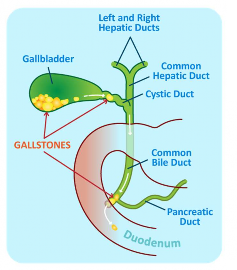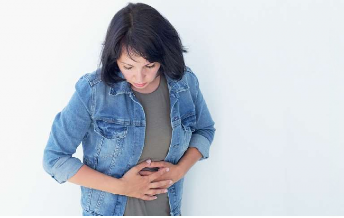
What are gallstones?
Gallstones (biliary calculi) are small pebble-like substances that form in the gallbladder.
The gallbladder is a small pear-shaped pouch that lies below the liver. Bile is made in the liver and stored in the gallbladder until the body needs it. The presence of fatty food triggers the gallbladder to squeeze bile into the small intestine.
Bile helps with digestion and breaks up fat that is eaten. It contains water, cholesterol, fats, bile salts, proteins and bilirubin (a waste product). If bile contains an imbalance of too much cholesterol, bile salts or bilirubin, it can harden into gallstones.
Gallstones can block the normal flow of bile if they move from the gallbladder and lodge in any of the ducts (tube- like passageways) that carry bile from the liver to the small intestine. These ducts include the:
- Hepatic ducts – which carry bile out of the liver
- Cystic duct – which takes bile to and from the gallbladder

- Common bile duct – which takes bile from the cystic and hepatic ducts to the small intestine.
VectorMine| shutterstock.com
Gallstones can be as small as a grain of sand or as large as a golf ball. The gallbladder can develop just one large stone, hundreds of tiny stones or a combination of large and tiny stones.

Korolev | depositphotos.com
Why do gallstones form?
There is no single cause of gallstones. The three types of gallstones are cholesterol stones, pigment stones and mixed stones.
Cholesterol stones
If the liver produces too much cholesterol, crystals made of cholesterol can form in the bile and harden to become stones. Cholesterol stones can grow to significant sizes, large enough to block bile ducts.
Pigment stones
Numerous small dark stones form because of changes in other bile components or because the gallbladder fails to empty normally.
Mixed stones
These are the most common type and tend to develop in batches. They are made of cholesterol and salts.
Gallstones become more common when we get older and can be found in up to 15% of people aged 50 years or older. They are also more common in:
- Females
- People who are overweight
- People who have a family history of gallstones
- People with diabetes
- People taking triglyceride-lowering medicines (fibrates)
- People who have rapid weight loss
What symptoms do gallstones cause?
In most cases, gallstones don’t cause any problems, and 7 out of 10 people have no symptoms.
The most common symptoms include:
- Pain in the abdomen (belly) and back – pain is generally infrequent but severe
The most common symptoms are episodes of moderate or severe pain in the upper abdomen or back.
- Increasing abdominal (belly) pain after eating a fatty meal.
Most people with gallstones will never have a serious complication. However, if stones are present for many years, about 1 in 10 people will develop jaundice (a yellow discolouration of the skin and whites of the eyes), pancreatitis (inflammation of the pancreas) or infections.

Some of the specific complications relating to gallstones can include:
- Obstructive jaundice or cholestasis: A blockage of flow in the bile ducts causes higher levels of bilirubin (one of the components of bile) in the blood, which results in jaundice (skin and whites of the eyes become yellow).
- Biliary colic: A blockage of the cystic duct (the neck of the gallbladder) causes severe pain and fever. There is no inflammation.<
- Cholecystitis: This is inflammation of the gallbladder, which can be accompanied by infection. Often there is pain, nausea and vomiting.
- Cholangitis: This is inflammation and infection of the bile duct, which may happen if the bile duct becomes blocked and then infected with bacteria from the small intestine.
- Pancreatitis: Occasionally, stones at the lower end of the bile duct cause inflammation of the pancreas gland, which can be a very painful condition.
- Gallstone ileus: Gallstones pass through to the intestine, where they can then cause a blockage in the small or large intestine.
These complications often require urgent treatment in hospital, but surgery to prevent them is rarely a good idea.
Symptoms of indigestion, fullness, nausea and fatty food intolerance are not caused by gallstones and won’t be made better by surgery.
How are gallstones diagnosed?
The first test is usually an ultrasound, which is painless, fairly simple and very accurate for locating stones in the gallbladder.
Other tests and procedures may be needed if there are complications or if it is likely there are stones in the bile duct. For example, EUS (endoscopic ultrasound) may be needed to diagnose stones in the bile duct if the doctor strongly suspects they are there, even if no stones are seen on abdominal ultrasound or other types of scans, like CT (computed tomography), MRI (magnetic resonance imaging) or MRCP (magnetic resonance cholangiopancreatography).
ERCP (endoscopic retrograde cholangiopancreatography) may be needed to remove stones from the bile duct. A flexible tube, called an endoscope, is passed through the oesophagus (food pipe) and stomach into the small bowel so the doctor can check for problems. Then a thin tube is passed through the endoscope into the bile duct, and x- rays are taken to help with removing the stones.
What are the treatment options?
Medical treatment may not be needed unless the gallstones cause symptoms. Treatment depends on the size and location of the gallstones but may include:
- Dietary changes: Limiting or eliminating fatty foods and dairy products.
- Surgery: If you have episodes of pain, your doctor may recommend an operation to remove either the stones from the bile duct or the entire gallbladder.
- Lithotripsy: A special machine generates sound waves to shatter stones. This treatment is used for people with large and difficult-to-remove stones.
- Medication: Some drugs can dissolve gallstones, but this treatment is not often used because it has side effects and is not always successful.
Urgent treatment is needed if a patient has complications such as jaundice or infections in the gallbladder or bile duct.
What sort of operation might I need?
Treatment will usually involve surgery or ERCP to remove stones from the bile duct using an endoscope.
If you have frequent gallbladder attacks, your doctor may recommend you have your gallbladder removed with an operation known as a cholecystectomy. Surgery to remove the gallbladder, which is a non-essential organ, is one of the most common operations performed on adults.
This operation is usually done by ‘keyhole’ (laparoscopic) surgery. The operation requires three small incisions (cuts) in the abdomen and usually 1 or 2 days in hospital afterwards.

Acknowledgements
This resource was reviewed and updated by the following health professionals in 2021:
Dr William Wang
Clin A/Prof Payal Saxena
Department of Gastroenterology and Hepatology, Royal Prince Alfred Hospital, Sydney, NSW, Australia
![]()
Requests and enquiries concerning reproduction and rights should be addressed to: Gastroenterological Society of Australia (GESA) Level 1, 517 Flinders Lane, Melbourne VIC 3000 | Phone: 1300 766 176 | email: gesa@gesa.org.au | Website: http://www.gesa.org.au

This document has been prepared by the Gastroenterological Society of Australia and every care has been taken in its development. The Gastroenterological Society of Australia and other compilers of this document do not accept any liability for any injury, loss or damage incurred by use of or reliance on the information. This work is copyright. You may download, display, print and reproduce this material in unaltered form only (retaining this notice) for your personal, non-commercial use or use within your organisation. Apart from any use as permitted under the Copyright Act 1968, all other rights are reserved. © 2021 Gastroenterological Society of Australia ABN 44 001 171 115.
Occasionally, keyhole surgery is impossible or risky, and the gallbladder is instead removed through a longer incision below the right-sided ribs, known as ‘open surgery’. This requires a longer stay in hospital, perhaps from 5 to 8 days.
Operations such as these are very safe but always carry a small risk of problems during surgery (such as bleeding or damage to the bile duct) and later complications, such as chest infections. Occasionally, x-rays taken during the operation may show a stone in the bile duct that requires an ERCP procedure later on. If you are concerned about possible risks, ask your doctor for more information.
Will an operation cure my symptoms?
Surgery can cure symptoms caused by gallstones. You can live perfectly well without your gallbladder! After surgery, bile made in the liver will keep helping with digestion, and you will not need to change your diet. Stones can still form and cause blockage in the bile duct, but this is much rarer without a gallbladder.


